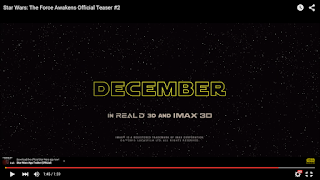I watched around twelve film trailers from all different genres, and I noticed some key codes and conventions appearing in the majority of them.
Production logos was usually the first thing that was seen in the trailer, after the green screen of "approved for appropriate audiences", as seen below.
Macbeth, Concussion, Cinderella and Suffragette all had the production company logos at the beginning of each trailer.
This enables the audience to know straight away who the producers of the film are, and in turn, what to expect from the film. For example, having the Disney logo as one of the first things you see as you watch the trailer, the audience would expect and know that a family friendly film with fairy-tale aspects would be shown. This would also be useful for the trailer itself as having the logos at the beginning wouldn't interrupt the trailer in any way, making the most of the time and enabling the audience to immerse themselves in the trailer in order to get a good idea of what the film is going to be about and if it's for them or not.
Establishing shots are used in trailers to quickly get the setting across to the audience, without having to specify the exact location in which the film is taken place.
About Ray, Macbeth, Concussion and Star Wars Episode VII all include this feature.
(About Ray included a montage of establishing shots in order to get this across)
Establishing shots enable the audience to be aware of where the film is meant to be set very quickly by, usually, panning the main scene where the film is taking place. This is important for the audience as otherwise they would have no idea where it was set, for example the future, the past etc, and could possibly be confused. Establishing shots create a familiarity with the film before they have even seen the film.
The release date of the film is on the majority of trailers, unless they are teaser trailers which could include 'coming soon' or 'summer 2016' for example.

Release dates are important for the audience to know as it makes the film available for them to actually go and watch it. The release date is almost always shown during the middle of the trailer, stating 'this summer' or 'December', following with an actual date. This would create excitement and anticipation for the audience watching the film as they would want to know when the official date of the film is being released so they could go and watch the film. Especially if the trailer is being shown close to the release date, the audience would be excited and perhaps more likely to watch the film as it would be 'fresh' in their minds and therefore easily accessible for them to attend a screening.
Titles of the film in trailers typically are the last thing on the screen, before the release date. This is to ensure that the audience remember the name of the film, to make them more likely to actually go and see it. Even if they don't go and see it straight away, they could talk about it on social media sites - which the links for these are also seen in the trailer to encourage the audience to interact with the trailer and promote it even further. Titles are a very important feature of the trailer as without it, you'd obviously have no idea what the film was called which would defeat the point of the trailer all together really.
Some other codes and conventions that are included in trailers are shown below.


























